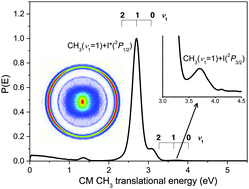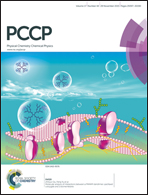New insights into the photodissociation of methyl iodide at 193 nm: stereodynamics and product branching ratios
Abstract
The stereodynamics of methyl iodide photodissociation after excitation at 193 nm has been studied using a combination of slice imaging and resonance enhanced multiphoton ionization (REMPI) detection of the methyl and iodine products. A weak anisotropic ring appearing in the image corresponding to vibrationally excited CH3(ν1 = 1) confirms the production of ground state I(2P3/2) atoms at this excitation wavelength as a signature of the predissociation channel reported previously [M. G. González et al., J. Chem. Phys., 2011, 135, 021102] tentatively assigned to the coupling between the B-band 3R1 Rydberg state and the A-band 1Q1 repulsive state. Direct REMPI detection of ground state iodine atoms indicates that most of the I(2P3/2) species are produced in correlation with highly internally excited methyl radicals, in excellent agreement with the recent results of Xu and Pratt [Xu et al., J. Chem. Phys., 2013, 139, 214310; Xu et al., J. Phys. Chem. A, 2015, 119, 7548]. From the comparison between the CH3(ν) second order Dixon's bipolar moments β20(20), β00(22), β20(02) and β20(22) measured in this work and those reported previously for the B-band origin and the A-band, a general picture of the CH3I photodissociation stereodynamics in terms of different effects, such as the breakdown of the unique recoil direction (URD) approximation, the non-adiabatic curve crossings and the depolarization induced by the parent molecule rotation, is drawn.



 Please wait while we load your content...
Please wait while we load your content...